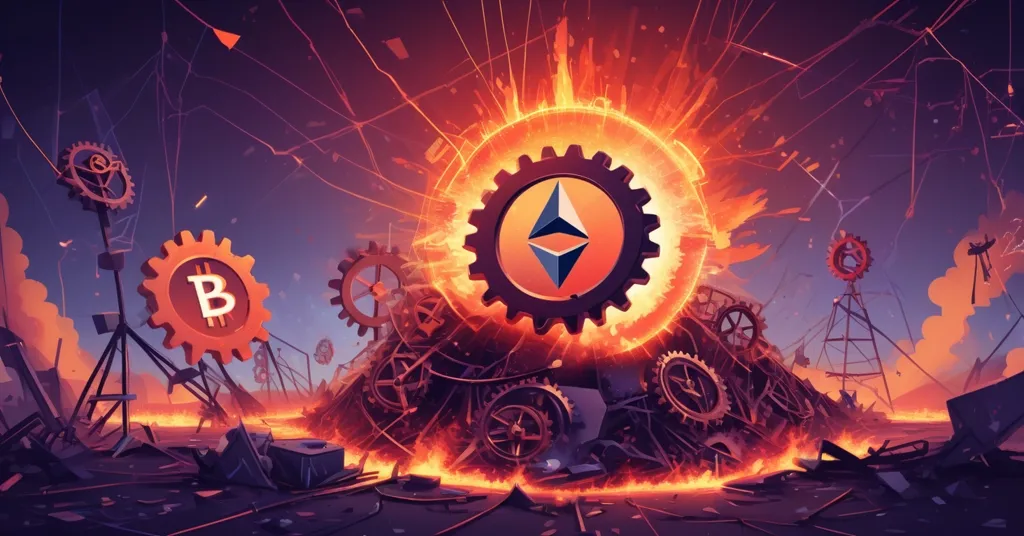Ethereum’s Fusaka Devnet 2 Fails Hard: Can Devnet 3 Save the Day?

Ethereum’s Fusaka Devnet 2 Crashes and Burns, Paving the Way for Devnet 3 Redemption
Ethereum’s latest testing phase for the Fusaka upgrade, known as Devnet 2, turned into a spectacular mess, exposing critical interoperability flaws with only 56% of client implementations reaching finalization. The Ethereum community has reframed this disaster as a “bug-hunt” to dig out obscure issues, while setting sights on Devnet 3 in mid-July for a smoother “happy-path” stress-test under near-production conditions.
- Devnet 2 Flop: Just 56% of clients finalized, revealing major compatibility breakdowns.
- Bug-Hunt Shift: Focus turned to uncovering edge-case failures in clients like Besu, Nethermind, and Nimbus.
- Devnet 3 Hope: Mid-July test to simulate real-world scenarios with finalized upgrades.
Understanding Ethereum Devnets: A Quick Primer
For those new to the space, Ethereum Devnets (Development Networks) are sandbox environments where developers test upgrades before they go live on the mainnet—the real blockchain where actual transactions and value are at stake. Think of them as dress rehearsals for a play, except when things go wrong, it’s not just a missed line but a potential multimillion-dollar fiasco. The Fusaka upgrade on Ethereum aims to enhance scalability and efficiency, crucial for a platform that underpins decentralized apps (dApps) and smart contracts. But as Devnet 2 showed, the road to progress is paved with potholes. These tests matter because Ethereum isn’t just one piece of software—it’s run by multiple client implementations, different versions of the same rulebook coded by separate teams. When they don’t sync up, the network risks splitting apart, a nightmare for a system built on consensus.
Devnet 2: A Brutal Reality Check
The results from Devnet 2 were nothing short of a wake-up call. With only 56% of clients achieving finalization—meaning they couldn’t all agree on the blockchain’s latest state—the test exposed how fragmented Ethereum’s ecosystem can be. Imagine a band where half the musicians are playing different songs; that’s the chaos of interoperability failure. Besu, a key Ethereum client, tripped over fork-ID arithmetic errors. Fork-IDs are like version tags for network upgrades, and Besu’s miscalculations meant it rejected valid peer connections, isolating itself like a hermit at a party. Nethermind, another major client, fumbled with four-byte chain identifiers—unique codes distinguishing one blockchain from another—leading to constant disconnects as if it kept hanging up on a critical phone call. Then there’s Nimbus, whose hybrid nodes combining Execution Layer (handling transactions) and Consensus Layer (managing agreement) failed to sync due to beacon root validation errors, basically leaving them offline and useless. For a deeper dive into these issues, check this detailed report on Devnet 2’s recast as a bug-hunt.
But the carnage didn’t stop at client missteps. Stress tests using a custom “spammer” tool, which bombarded the network with 12,000 large contracts over thousands of blocks, uncovered race conditions in transaction pool blob indexing. In simpler terms, when too many transactions hit at once, clients couldn’t organize data “blobs”—large chunks introduced post-Merge to lower costs via rollups—leading to bottlenecks. It’s like Ethereum tried to run a marathon with untied shoelaces, predictably stumbling. Add to that inconsistencies in MEVBoost relay workflows, where empty blob commitments weren’t tagged properly, and you’ve got friction in the economic layer. MEVBoost helps validators maximize profits by prioritizing transactions, so glitches here could mess with decentralized finance (DeFi) protocols and validator incentives, potentially costing users real money. More on these specific client failures in Devnet 2 can shed light on the technical breakdowns.
Real-World Stakes: Why These Bugs Hurt
These aren’t just nerdy coding errors to shrug off. If left unchecked until mainnet, they could wreak havoc on Ethereum’s users. Picture a DeFi yield farm—a platform where people stake crypto for returns—unable to process withdrawals because clients can’t sync. That’s lost money and shattered trust. Or consider dApp developers rolling out complex smart contracts, only to face deployment delays or failures due to network fragmentation. Even validators, the folks securing the network, could lose out on rewards if MEVBoost hiccups skew transaction prioritization. Ethereum’s post-Merge vision of scalability through data sharding and rollups hinges on seamless client interaction. Devnet 2’s failures are a stark reminder that the tech isn’t bulletproof yet, and every glitch now is a dodged bullet for later. Curious about what went wrong during testing? The discussion offers some valuable insights.
Community Response: From Wreckage to Recovery
Rather than dodge the embarrassment, the Ethereum community has leaned into it, rebranding Devnet 2 as a “bug-hunt.” It’s a gritty acknowledgment that sometimes you’ve got to smash things to see where they crack. This phase became a diagnostic sandbox, hunting down obscure failures no matter how niche. To address the root of these mismatches, developers are pushing EIP-7910, which rolls out the eth_config JSON-RPC method—a standardized way to set genesis parameters like gas schedules and blob limits. Think of it as forcing every client to read the same recipe before cooking, avoiding disasters like one chef using salt instead of sugar. Past testnet blunders, such as misconfigured deposit contracts on Holešky that lingered even after finality, prove why this matters. Without a unified starting point, tiny errors can snowball into permanent network quirks.
The response isn’t just theoretical. Client teams are adding locks around blob indexing to prevent race conditions, beefing up unit tests for fork transitions, and integrating performance checks into their workflows. Transparency shines through with structured review calls planned for July 31 and August 14, 2025, alongside tools like forkcast.org to track Ethereum Improvement Proposals (EIPs). It’s a messy but honest grind, showing a commitment to getting it right—even if it means airing dirty laundry. Community perspectives on these challenges are also being shared in forums like this Reddit thread discussing Devnet 2 failures.
Devnet 3: A Shot at Redemption
With Devnet 2’s autopsy complete, eyes turn to Devnet 3, set for mid-July as a “happy-path” stress-test. Unlike the free-for-all debugging of its predecessor, this phase aims to mimic real-world scenarios, proving the network can handle pressure without cracking. It’ll validate finalized EIPs like EIP-7907, which doubles contract size limits to support beefier dApps, and EIP-7594, capping blobs at six to manage data bloat. There’s also a nod to long-term fixes like history expiry via a unified ERAE-E format, tackling archival data overload—a pain point for node operators striving to keep Ethereum accessible. But let’s not get too cozy; what if blob caps throttle dApp growth instead of streamlining it? Or if stress tests unearth another hidden fracture? Devnet 3 isn’t just a checkbox—it’s a proving ground with high stakes. Get the latest updates on Devnet 3’s stress-test plans and finalized proposals.
Ethereum vs. Bitcoin: Different Beasts, Same Jungle
As someone who often leans Bitcoin maximalist, I’ll throw Ethereum a bone here. Bitcoin’s upgrades are a slow burn—deliberate, almost stubborn, prioritizing stability over flashy experiments. Ethereum, by contrast, is a mad scientist, constantly tinkering with a cauldron of new ideas. Devnet 2’s dumpster fire is the price of that ambition, and while I’d argue Bitcoin’s simplicity keeps it a purer store of value, Ethereum’s chaos fills niches Bitcoin doesn’t touch. DeFi, NFTs, and programmable money? That’s Ethereum’s turf, driving adoption in ways Bitcoin never will. Still, there’s a shadow side: this complexity—client diversity, endless upgrades—could undermine decentralization if it keeps tripping over itself. Is Ethereum innovating, or just overreaching?
Comparing Notes: Ethereum’s Struggles in Context
Ethereum isn’t alone in wrestling with upgrade pains. Solana’s faced network outages from transaction overloads, though its monolithic design sidesteps client diversity headaches. Cardano’s slow-roll upgrades aim for academic rigor but lag in adoption. Ethereum’s strength—multiple clients preventing a single point of failure—is also its Achilles’ heel when they don’t sync. Past testnets like Ropsten and Goerli saw similar stumbles, with client bugs delaying rollouts. Fusaka’s hiccups aren’t new; they’re just the latest chapter in a saga of growing pains. The difference now? Post-Merge, the stakes are higher with real-world DeFi and staking on the line. Ethereum’s betting big on fixes like EIP-7910, but history whispers caution.
The Bigger Picture: Grit Over Glamour
Fusaka ties into Ethereum’s broader push to solve nagging issues—high gas fees, node centralization, data bloat—while scaling to handle global demand. Roadmap talks of gas limits hitting 45 million signal ambition, but Devnet 2 shows how far there is to go. Every bug dodged now is an exploit avoided later, potentially saving billions in user funds. Yet, there’s a nagging question: does this relentless complexity make Ethereum more fragile than its peers? For all my Bitcoin bias, I admire the hustle—Ethereum’s willingness to stress itself to breaking for the sake of a censorship-resistant future. Devnet 3 will be the litmus test. Can they pull off a redemption arc, or are we in for another plot twist in this decentralized drama?
Key Takeaways and Questions
- What tanked Ethereum’s Fusaka Devnet 2?
Only 56% of clients finalized due to interoperability disasters—Besu’s fork-ID errors, Nethermind’s identifier fumbles, Nimbus’ sync failures, plus race conditions under heavy transaction loads. - How is Ethereum tackling these client mismatches?
They’re rolling out EIP-7910 with the eth_config JSON-RPC method to standardize genesis parameters, ensuring all clients start on the same page to avoid network splits. - Why reframe Devnet 2 as a ‘bug-hunt’?
It shifts focus to diagnosing obscure issues in a sandbox setting, prioritizing problem discovery over premature polish in a critical testing phase. - What’s the game plan for Devnet 3 in mid-July?
It’s a “happy-path” stress-test simulating real-world conditions, validating upgrades like EIP-7907 (larger contracts) and EIP-7594 (blob caps) to ensure stability. - Do these failures spell doom for Ethereum’s upgrades?
Not yet—they’re painful but fixable growing pains. The community’s transparency is a strength, though unresolved bugs could still bite hard on mainnet. - Is Ethereum’s complexity a flaw or a feature compared to Bitcoin?
It’s both—client diversity and constant innovation drive unique use cases like DeFi, but risk fragmentation; Bitcoin’s simplicity offers resilience at the cost of flexibility.



